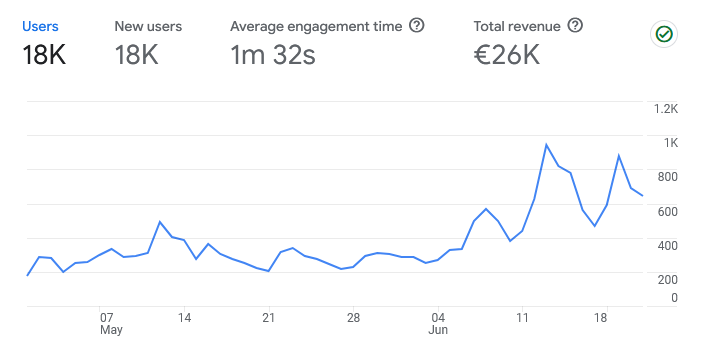- Step 1: Analysis of the current situation
- Step 2: Defining goals and target audience
- Step 3: Planning the new design and user experience
- Step 4: Implementing technical improvements
- Step 5: Website Redesign – Content Strategy
- Step 6: Implementation of the SEO optimization strategy
- Step 7: Testing and improvements
- Conclusion:
A website redesign is crucial to improving your online presence and reaching competitive advantagesIn this article, we will explore the importance of a website redesign and present you with 7 key steps that will help you implement it. successful website renovation.
Step 1: Analysis of the current situation

Before you embark on a website redesign, it's important to thoroughly analyze your current situation. Review all aspects of your website, including user experience, performance, online visibility, and sales results. Use analytics tools like Google Analytics and Google Search Consoleto gain insights into page traffic, visitor behavior, conversions, and other key metrics.

In analysis user experience rate how easy it is to navigate the website, how fast pages load, whether the information is clear and easily accessible, and whether there are any barriers that may affect user interaction. Also check the responsiveness of your website on different devices, such as mobile phones, tablets, and computers.
When it comes to performance, focus on key metrics like conversion rate, average time on site, bounce rate, and other metrics that are important to your business goals. Also, check your website's visibility on search engines and analyze the keywords your website is already ranking for and what opportunities there are for improvement.
Based on the analysis, you will be able to identify strengths, weaknesses, and opportunities for improvement. Since website redesign can be difficult, this will greatly help you plan and target key areas for improvement.
Step 2: Defining goals and target audience

For a website redesign to be successful, it is crucial to have clearly defined goals. Determine what you want to achieve with the redesign – do you want to increase sales, improve user experience, increase the number of inquiries or achieve some other business goal. Goals must be measurable, achievable and time-bound.
It is also important to define the target audience of your website. Think about the demographics, interests, needs, and preferences of your target audience. This will help you tailor your website content, design, and functionality to better address and satisfy the needs of your users.
A website redesign with clearly defined goals and target audience will allow you to plan your redesign in a more focused manner and successfully achieve the desired results.
Step 3: Planning the new design and user experience

When planning a new website design, it is crucial to create an attractive visual appearance that is consistent with your brand, as a website redesign can focus on shortcomings and forget about what worked before. Think about the color scheme, typography, use of images and other visual elements that will create a positive and consistent user experience.
At the same time, focus on easy navigation. Users should be able to find the information they want quickly and easily. Make sure the main menu is clear and user-friendly. Consider using submenus and a search box for additional navigational assistance.
In addition, it is important that the redesigned website works quickly and flawlessly. Optimize speed page loading, use image compression and check that all connections and functionalities are working properly.
Step 4: Implementing technical improvements

When redesigning your website, also focus on the technical aspects. Page loading speed optimization is crucial as users expect a fast and smooth experience. Check that images are properly compressed, improve page caching and make sure your website is mobile-friendly.
Also, take care of the security of your website, because a website redesign usually means new hosting, a new system, and therefore new threats. Use security solutions such as an SSL certificate to ensure encrypted communication between users and your website. Regularly update all plugins and the platform to prevent potential security vulnerabilities.
Additionally, make sure that the structure of your website is well-designed and organized. A proper structure allows for better indexing by search engines and improves the user experience. Use meaningful URLs, structure your content appropriately, and ensure that all links are working properly.
Step 5: Website Redesign – Content Strategy

A successful website redesign also requires consideration of content strategy. Content is key to attracting users, maintaining interest, and achieving goals.
Develop a content plan that meets the needs of your target audience. Outline the topics you want to cover and create regular content updates that will benefit your users. Pay attention to content quality, proper keyword usage, and structuring your content for better search engine optimization.
Consider creating blog posts, guides, manuals, or other informative content that will help users solve their problems or satisfy their needs. Also include visual elements like images and videos to enrich the content and attract more attention, as a website redesign is not only technical, but also content-based.
Online store renovation It is a good opportunity to review content such as categories and products to ensure they have appropriate professional images, descriptions, and other information.
Step 6: Implementation of the SEO optimization strategy

Search engine optimization (SEO) is crucial for achieving higher search rankings and driving organic traffic to your website. Conduct thorough keyword research that is relevant to your industry and target audience. Include these keywords in your titles, meta tags, URLs, and page content.
Additionally, use a proper internal linking system to connect related content on your redesigned website. This will allow for better indexing and help users navigate your website.
This is also a good time to consider whether your website redesign can bring in some quality backlinks from other websites. You can achieve this through strategies such as hosting guest blogs, participating in industry directories, or exchanging content with other relevant websites.
Step 7: Testing and improvements
Website development and website redesign are very similar, but we usually have more experience with redesign and know what to look out for.

Before launching a redesigned website, it is important to thoroughly test all functionality. Check that all links are working, forms are working properly, content is displayed correctly, and the page displays correctly on different devices, and of course website speed on different devices.
In addition to technical testing, focus on user experience. After a website redesign, ask a few friends, colleagues, or users to test the website and gather feedback on their experience. Analyze this feedback and make any improvements to ensure that the website is as intuitive, useful, and engaging as possible for visitors.
After launch, monitor analytics regularly to track the performance of your revamped website. Analyze key metrics such as traffic, conversion rate, time spent on site, and other important metrics. Use the data to make improvements to optimize your website and achieve the desired results.
Conclusion:
A website redesign is a comprehensive process that requires careful planning and execution. By following the seven steps outlined above, you will be able to create a revamped website that will: increase your online presence, improve user experience, increase sales and achieve your business goals. Don't forget to regularly monitor and customize the websiteto stay competitive and keep up with changes online. Follow these seven steps to make your website redesign a success.
If you want help or free consultation on website development me contact now.

